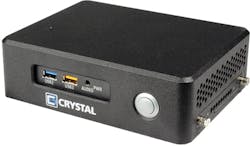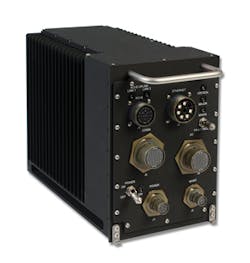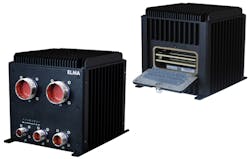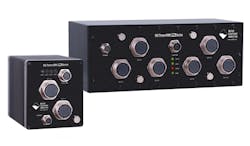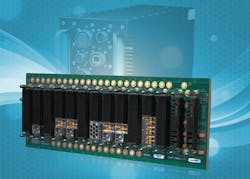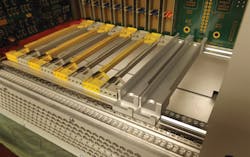Military systems designers are on the lookout for off-the-shelf systems that are small, powerful, rugged, and have the ability to cool the most powerful microprocessors.
Military electronic systems integrators who specify chassis and enclosures are looking for products that are rugged, easily upgradable, offer small size and low weight, and have adequate I/O and data throughput speeds to accommodate a wide variety of applications, now and in the future.
These chassis and enclosures must be able to accommodate popular connectivity demands, such as VPX, Non-Volatile Memory Express (NVMe), PCI generations 3 and 4, and perhaps even a new generation of optical interconnects that will provide adequate throughput for the latest applications in image and video processing, electronic warfare (EW), signals intelligence (SIGINT), and radar and sonar processing.
Chassis and enclosures also must have the on-board cooling and thermal management capabilities to handle tightly packed boards in the smallest of enclosures, as well as power server-class processor boards running chips like the Intel Xeon.
Accommodating these kinds of design demands can be a big challenge, but the requirements don't end there. Despite these crucial demands for small size, weight, and power consumption (SWaP), extreme ruggedness, fast connectivity, and robust thermal management, systems designers also are looking for the relative low costs and high availability of commercial off-the-shelf (COTS) equipment. There are more than enough design issues to keep chassis suppliers up at night.
The box approach
Chassis and enclosures for military embedded computing typically are highly engineered boxes that contain circuit boards for processors, I/O, data storage, and other functions that comprise an embedded computing system. These boxes most often are ruggedized to stand up the rigors of shock and vibration, temperature extremes, and electromagnetic interference. Often, but not always, these boxes contain backplanes for plugging in the circuit cards that provide inter-card data communications.
It's the systems designer's job to match the box to the application. A small combat vehicle, for example, might need the smallest size and weight possible, with plenty of I/O connectors for on-board peripheral systems. It has to provide protection against shock and vibration, and probably must rely on conduction cooling.
A large manned aircraft, on the other hand, most likely can accommodate a standard air transport rack (ATR) box, which can have room for high-performance backplanes and the fans necessary for convection cooling. Some ATRs also can accommodate more exotic thermal management like liquid flow-through cooling. Shipboard systems should have the size, weight, and power budget to accommodate large systems like 6U VPX. Smaller platforms like jet fighter aircraft are sensitive to size and weight, yet require powerful computing, so a 3U VPX system might satisfy requirements.
For each application the designer must make tradeoffs in size, performance, power consumption, thermal management, and computer performance. No matter what a designer's requirements are, however, it's likely he'll be able to find the kind of chassis and enclosure he needs from a large U.S. and international supplier base.
The need for SWaP
Requirements for size, weight, and power consumption - better-known as SWaP - are among the systems designer's most important concerns in specifying a chassis and enclosure.
"The lighter and the smaller it is that you can fit components in, the better," says Justin Moll, vice president of U.S. market development at chassis supplier Pixus Technologies in Waterloo, Ontario.
Computing components typically become smaller, more powerful, and more power efficient every year. That means that what used to fit into a standard ATR enclosure years ago might be able to fit on a 6U or 3U card today. The capability that only recently fit on a 6U VME card today might fit on a credit card-sized mezzanine card.
"Our customers are looking for smaller form factors in a rugged box or ATR for avionics and airborne applications, as well as for rackmount applications," says Ram Rajan, senior vice president at Elma Electronic in Fremont, Calif. "Backplane architectures are getting dense. What used to be box level is gravitating toward the single-slot board. Topologies on the backplane are supporting higher data rates. We also see customers asking for more small-form-factor ATRs where we primarily see 3U VPX conduction-cooled boxes."
Although 3U VPX has become a popular form factor, some designs are going even smaller. "There's an emerging trend in COM Express in server applications," Elma's Rajan says. "It brings together a lot of flexibility that VPX might not be able to address. COM Express is something to look out for. It's also moving toward mobile applications." The VITA 74 small-form-factor standard called VNX also has promise for the future of extremely small systems.
Not only does shrinking size and increasing performance mean smaller architectures, but it also means that systems designers can place vastly more powerful computer systems in same-size or smaller spaces. This is proving a huge benefit for systems upgrades in avionics, vetronics, shipboard electronics, and other aerospace and defense applications. Legacy electronics that comes out of one space can accommodate extremely powerful replacements.
Rackmount architectures, which have been able to accommodate legacy computer boards for years, also can facilitate relatively new board form factors and backplanes, and so are popular with systems integrators.
"Rackmount will be around for a long, long time," says Bob Judd, director of marketing at United Electronic Industries (UEI) in Walpole, Mass. "On aircraft where real estate is a premium, people are able to go to smaller form factors. Even in shipboard electronics, racks are still a nice, solid, and dense way to put together a system."
The overall trend, however, is heading in the direction of SWaP. "A lot of stuff we see is going to smaller and smaller form factors," says Pixus's Moll. "Systems are denser, and there is less need to use fans where you could use conduction cooling. This makes for better reliability, fewer maintenance concerns, and so on. That continues to be a trend of people who want smaller sizes, but also who don't have needs for specific form factors, like ATR."
Demands for SWaP also are leading chassis and enclosures companies in non-traditional directions. Where ruggedized aluminum or other lightweight metals often are the choice for aerospace and defense embedded computing, Crystal Group in Hiawatha, Iowa, is using something new: carbon fiber.
"In terms of chassis design, we continue to have customers asking for our standard billet [aluminum] chassis, which is extremely rugged, extremely stiff, and low deflections in shock and vibration," says Jim Shaw, executive vice president of engineering at Crystal Group. "We also are seeing an emphasis on weight."
This has led Crystal Group designers in a different direction. "We have been doing a lot of work in carbon fiber," Shaw says. "Originally we saw that as just for the airborne market, but it also is a factor in transit cases that people have to lift and transport." Carbon fiber is an important part of the Crystal Group RE1312 and RE1401 rugged embedded computers.
"Moving from aluminum to carbon fiber saved us some weight and saved some space; it works out to be a good application," Shaw says. We had to do some special things to layer stackup for EMC [electromagnetic compatibility] within the carbon fiber." Shielding with carbon fiber is not optimal, he explains, and company engineers tackle the problem with proprietary technology. "We did a complete EMI [electromagnetic interference] series of testing, and we have a report that shows compliance to MIL-STD-461."
Despite EMI challenges with carbon fiber, however, the material's weight savings is worth it, Shaw says. Crystal Group engineers were able to cut about one-third of the weight of embedded computing systems by using carbon fiber enclosures, Shaw says. Using carbon fiber reduced the weight of one system from 22 pounds to 14 pounds, for example.
Cooling and thermal management
When it comes to customer requirements, efficient cooling and thermal management runs a close second to SWaP for chassis and enclosures. It's a constant that high-performance electronics generates heat, and heat often is the cause of degraded system performance and system failures.
"Feeding the system power is not the issue; getting the heat out of the box is," says UEI's Judd. Especially for extremely small systems, conduction cooling is virtually the only solution to meet requirements for size, ruggedness, and power budget. "It has to be heat sinks and fins and things like that," Judd says. "If you need waivers for rotary cooling, it makes everyone's life difficult."
Typically there are three types of cooling and thermal management for chassis and enclosures: conduction cooling, or removing the heat by conducting it away from hot components; convection cooling, or removing heat with fan-driven blowing air; and liquid cooling, or removing the heat with liquid that flows through boards and enclosures, or that is sprayed over hot components and recirculated.
Typically the most straightforward approach - especially for SWaP-constrained systems - is conduction cooling, which takes relatively little space, requires no extra power, and is inherently rugged.
"We see requirements for conduction-cooled boards, and 3U VPX is perfect for this," says Elma's Rajan. "3U VPX is a very robust solution, especially for backplane applications."
Even though conduction cooling typically is the least expensive thermal-management approach for rugged systems, it still introduces some costs in the form of metal card edges that conduct heat away from boards, as well as fins on and around boards to conduct heat to the outside of chassis and enclosures.
In recognition of these design costs, Pixus offers conduction-cooled card guides, which enable designers to experiment with conduction-cooled designs using non-ruggedized, fan-cooled technology.
"Cards can plug into a standard air-cooled chassis, just for development," says Pixus's Moll. "Designers also can block off air flow to test conduction cooling. You can test air-cooled cards right next to conduction-cooled cards."
Some high-powered systems, however, simply generate too much heat for conduction cooling to handle. "In some systems, conduction cooling is very tough, unless you want the expensive and complex forms of cooling," Pixus's Moll says. In these cases, systems designers typically look to fan-driven blown air, with various approaches for air channeling.
"We have heavy-duty fans that we are using in some of the rackmount systems for VPX," says Pixus's Moll. "What's nice is they have the optional features of hot-swapability, system management of those fans, very high CFM [cubic feet of air per minute]. The fan is directly above the card cage, so cooling is an efficient process, as opposed to having fans in the rear with a bend in the air flow."
Using blown air in military em- bedded systems can have several drawbacks, so systems designers typically avoid this approach unless it's absolutely necessary. First, convection cooling almost always is more expensive than conduction cooling. Second, it introduces challenges with ruggedness and maintainability; fans are moving parts and so are subject to failure and frequent maintenance. Third, fans can be single-points of failure if they fail unexpectedly. Last, fans take more space and require more power than conduction cooling. Designers also must craft relatively unobstructed air channels to make the most of blown air.
Some military embedded systems are too powerful, and generate too much heat, even for convection-cooled systems to deal with efficiently. This is where liquid cooling from companies like Parker Hannifin Corp. in Cleveland come in. Parker offers liquid flow-through cooling, as well as spray cooling for systems using top-end microprocessors and other hot components.
Parker also is developing self-contained, liquid-cooled chassis and enclosures for applications that have no other liquid source for cooling, such as liquid fuel. These liquid-cooled chassis, which can accommodate cards with and without liquid flow-through cooling are being developed to be cost-competitive with other forms of thermal management, says Michael Humphrey, the business development manager for thermal management solutions at Parker.
I/O and connectivity
Today's chassis and enclosures for aerospace and defense applications offer a wide variety of architectures, connectivity, and I/O to accommodate the widest variety of ruggedized applications possible. These solutions come in standard off-the-shelf versions, value-added solutions, and full-custom solutions for the most demanding requirements.
Systems designers must balance requirements for low cost and high performance, so they most often consider COTS first. "The big thing we're seeing is people want COTS capability," says UEI's Judd. "We're really being pushed to go COTS. Everyone is panicked about custom development, how much it costs, and how much it costs two years down the road when you need to make a change."
Where in years past designers of rugged military embedded systems often chose VME and CompactPCI as their most popular COTS solutions, "those are now gravitating toward VPX," says Elma's Rajan.
"VPX is the choice for new defense programs," says Ken Brown, manager of applications and programs at LCR Embedded Systems Inc. in Norristown, Pa. "Most of that is 3U VPX in an ARINC 404 enclosure," Brown told attendees in January at the ETT conference. "VPX is popular, it has a ton of I/O, can handle high-speed I/O in RF and fiber options, and there is ultimately no limitations on where you bring I/O out of a VPX box."
VPX comes in 6U and smaller 3U versions and is becoming one of the most popular choices for demanding aerospace and defense applications. It is rugged, available off the shelf, accommodates a variety of cooling and thermal management techniques, and has the potential for relatively easy upgrades in the future.
Those aren't the only advantages of VPX. It offers throughput of 16 gigabits per second per channel on versions available today, and speeds of at least 25 gigabytes per second per channel expected for future versions. In addition, VPX is starting to accommodate optical transceivers to offer designers the option of moving data over copper or over optical fiber.
The speed doesn't stop there. "In two or three years we need to make sure we have backplanes and connectors that can support 100-gigabit-per-second data rates," says Elma's Rajan. "Optical, over the last year and a half, has been more widely used to handle this output."
Embedded computing chassis and enclosures company list
A&J Manufacturing Co.
Tustin, Calif.
http://aj-racks.com/
Abaco Systems Inc.
Huntsville, Ala.
www.abaco.com/
Acromag Inc.
Wixom, Mich.
www.acromag.com/
ADL Embedded Solutions
San Diego
www.adl-usa.com
Alligator Designs Pvt. Ltd
Bangalore, India
http://alligatordesigns.com/
Artesyn Embedded Technologies
Tempe, Ariz.
www.artesyn.com/
Atrenne Computing Solutions
Brockton, Mass.
www.atrenne.com/
Crystal Group
Hiawatha, Iowa
www.crystalrugged.com/
Curtiss-Wright Defense Solutions
Ashburn, Va.
www.curtisswrightds.com/
Ecrin Systems
Crolles, France
www.ecrin.com/
Elma Electronic
Fremont, Calif.
www.elma.com/
Extreme Engineering Solutions (X-ES)
Middleton, Wis.
www.xes-inc.com/
General Micro Systems Inc. (GMS)
Rancho Cucamonga, Calif.
www.gms4sbc.com/
Gichner Shelter Systems
Dallastown, Pa.
www.gichner.us/index.html
Kontron
Poway, Calif.
www.kontron.com/
LCR Embedded Systems Inc.
Norristown, Pa.
www.lcrembeddedsystems.com/
Meggitt Defense Systems Inc.
Irvine, Calif.
www.meggittdefense.com/
Mercury Systems
Chelmsford, Mass.
www.mrcy.com/
Parker Hannifin Corp.
Cleveland
www.parker.com
PCI Systems Ltd.
Sunnyvale, Calif.
www.pcisystems.com/
Pixus Technologies
Waterloo, Ontario
www.pixustechnologies.com/
Systel Inc.
Sugar Land, Texas
www.systelusa.com/
Themis Computer
Fremont, Calif.
www.themis.com/
United Electronic Industries (UEI)
Walpole, Mass.
www.ueidaq.com/
Vadatech Inc.
Henderson, Nev.
www.vadatech.com/
